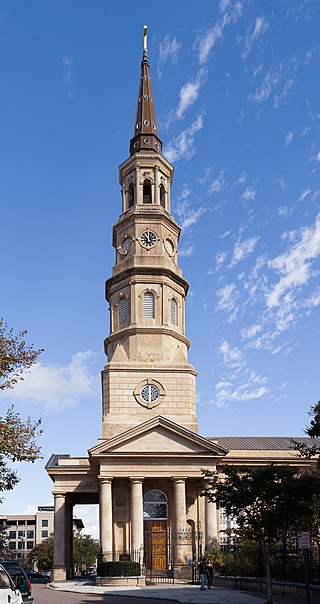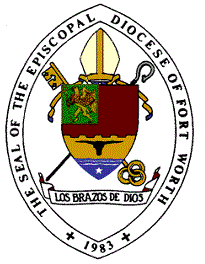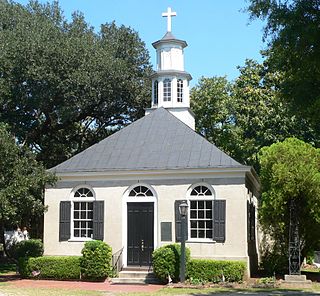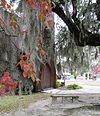
The Episcopal Church in North Texas was a diocese of the Episcopal Church from 1982 to its merger with the Diocese of Texas in 2022. The diocese included a geographic area of 24 counties in the north central part of Texas. As of 2021, it includes 13 churches, including a number of other congregations in the process of reorganization. The jurisdiction was the site of a major schism in 2008. This schism was the result of the diocese's bishop, Jack Iker, leading the majority of clergy and parishes to join the Anglican Church of North America as the Episcopal Diocese of Fort Worth. The Episcopal Church diocese is headquartered in Fort Worth, Texas. It announced on April 22, 2022, that it would seek reunion with the Episcopal Diocese of Texas. The merger was finalized by the 80th General Convention of the Episcopal Church in the United States of America on July 11, 2022.

The Episcopal Diocese of Pittsburgh is a diocese in the Episcopal Church in the United States of America. Geographically, it encompasses 11 counties in Western Pennsylvania. It was formed in 1865 by dividing the Episcopal Diocese of Pennsylvania. The diocesan cathedral is Trinity Cathedral in downtown Pittsburgh. The Rt. Rev. Ketlen A. Solak was consecrated and seated as its current bishop in autumn 2021.
In the United States, the history of the Episcopal Church has its origins in the Church of England, a church which stresses its continuity with the ancient Western church and claims to maintain apostolic succession. Its close links to the Crown led to its reorganization on an independent basis in the 1780s. In the nineteenth and early twentieth centuries, it was characterized sociologically by a disproportionately large number of high status Americans as well as English immigrants; for example, more than a quarter of all presidents of the United States have been Episcopalians. Although it was not among the leading participants of the abolitionist movement in the early 19th century, by the early 20th century its social engagement had increased to the point that it was an important participant in the Social Gospel movement, though it never provided much support for the Prohibitionist movement. Like other mainline churches in the United States, its membership decreased from the 1960s. This was also a period in which the church took a more open attitude on the role of women and toward homosexuality, while engaging in liturgical revision parallel to that of the Roman Catholic Church in the post Vatican II era.
The Anglican realignment is a movement among some Anglicans to align themselves under new or alternative oversight within or outside the Anglican Communion. This movement is primarily active in parts of the Episcopal Church in the United States and the Anglican Church of Canada. Two of the major events that contributed to the movement were the 2002 decision of the Diocese of New Westminster in Canada to authorise a rite of blessing for same-sex unions, and the nomination of two openly gay priests in 2003 to become bishops. Jeffrey John, an openly gay priest with a long-time partner, was appointed to be the next Bishop of Reading in the Church of England and the General Convention of the Episcopal Church ratified the election of Gene Robinson, an openly gay non-celibate man, as Bishop of New Hampshire. Jeffrey John ultimately declined the appointment due to pressure.
The Dennis Canon is a common name used for Title I.7.4 of the Canons of the Episcopal Church in the United States of America.
The Anglican Diocese of San Joaquin (ADSJ) is a diocese in the Anglican Church in North America (ACNA). It came into being after a majority of congregants in the Episcopal Diocese of San Joaquin separated from the Episcopal Church in 2007. Prior to the separation, the Episcopal Church diocese was one of the most conservative in the church, and one of three that did not ordain women. The Anglican diocese is now headquartered in Fresno. The pre-separation diocese had a membership of approximately 8,500.

The Anglican Church in North America (ACNA) is a Christian denomination in the Anglican tradition in the United States and Canada. It also includes ten congregations in Mexico, two mission churches in Guatemala, and a missionary diocese in Cuba. Headquartered in Ambridge, Pennsylvania, the church reported 977 congregations and 124,999 members in 2022. The first archbishop of the ACNA was Robert Duncan, who was succeeded by Foley Beach in 2014.

St. Philip's Church is an historic church at 142 Church Street in Charleston, South Carolina. Its National Historic Landmark description states: "Built in 1836, this stuccoed brick church features an imposing tower designed in the Wren-Gibbs tradition. Three Tuscan pedimented porticoes contribute to this design to make a building of the highest quality and sophistication." On November 7, 1973, it was added to the National Register of Historic Places and designated a National Historic Landmark.

The Episcopal Diocese of Fort Worth is a diocese of the Anglican Church in North America. The diocese comprises 56 congregations and its headquarters are in Fort Worth, Texas.

Christ Episcopal Church is a church located in Mount Pleasant, South Carolina.
Mark Joseph Lawrence is an American bishop. He was the bishop of the Episcopal Diocese of South Carolina from 2008 to 2012, and of the diocese now known as the Anglican Diocese of South Carolina from 2012 to 2022. In November 2012, under his leadership, a large portion of the old diocese withdrew from the national Episcopal Church to become an independent Anglican diocese. They continued to operate under the name "Episcopal Diocese of South Carolina", whose use was disputed by the national Episcopal Church. The Episcopal Church did not recognize this diocesan withdrawal, instead considering Lawrence to have abandoned the church and his position as diocesan bishop. Lawrence's diocese affiliated with the Anglican Church in North America in 2017 and in 2019 began referring to itself as the "Anglican Diocese of South Carolina".

The Episcopal Diocese of South Carolina (EDOSC), known as The Episcopal Church in South Carolina from January 2013 until September 2019, is a diocese of the Episcopal Church. The diocese covers an area of 24 counties in the eastern part of the U.S. state of South Carolina. The see city is Charleston, home to Grace Church Cathedral and the diocesan headquarters. The western portion of the state forms the Episcopal Diocese of Upper South Carolina. As a diocese of the Episcopal Church, the Diocese of South Carolina is part of the worldwide Anglican Communion and traces its heritage to the beginnings of Christianity.
Ruth Woodliff-Stanley is a prelate of the Episcopal Church and currently serves as the 15th Bishop of South Carolina. She is the 1,137 Bishop consecrated for the church. Woodliff-Stanley is the first regular diocesan Bishop for the Diocese of South Carolina since 2012, and the first female Bishop in the over 200 plus years of the diocese's existence.
Charles F. "Chip" Edgar III is an American Anglican bishop. He has been bishop of the Anglican Diocese of South Carolina (ADOSC) since 2022.
William Avery Thompson (1946–2020) was an American Anglican bishop. A key figure in the Anglican realignment in the United States, he was the longtime rector of All Saints Episcopal Church, which left the Episcopal Church for oversight by the Church of Uganda in 2004. He became a leader in the Common Cause Partnership, which in 2009 emerged as the Anglican Church in North America, and in 2009 was elected the first bishop of the ACNA's Diocese of Western Anglicans.
David C. Bryan is an American bishop of the Anglican Church in North America. Consecrated in 2013 to serve in PEARUSA, the Anglican Church of Rwanda's missionary district in North America, Bryan has since 2016 been bishop suffragan and area bishop for South Carolina in the Diocese of the Carolinas.

Terrell Lyles Glenn Jr. is an American bishop of the Anglican Church in North America. He is a former Episcopal priest who played an active role in the Anglican realignment in the United States. Consecrated in 2008 to serve as a bishop in the Anglican Mission in the Americas, Glenn is now an assisting bishop overseeing North Carolina congregations in the Diocese of the Carolinas.
Thomas William "T. J." Johnston Jr. is an American lawyer and bishop of the Anglican Church in North America. As the first Episcopal priest whose orders were transferred to the Anglican Church of Rwanda in the 1990s, Johnston was a key figure in the Anglican realignment in the United States. Consecrated as a bishop in 2001 to serve in the Anglican Mission in the Americas, Johnston later became a church planter in South Carolina.

St. Andrew's Church is a multisite Anglican congregation in Mount Pleasant, North Charleston, and Charleston, South Carolina. First established in 1835, its 1857 building is a contributing property to the Mount Pleasant Historic District. The church holds services at two other locations: downtown Charleston and North Charleston.























